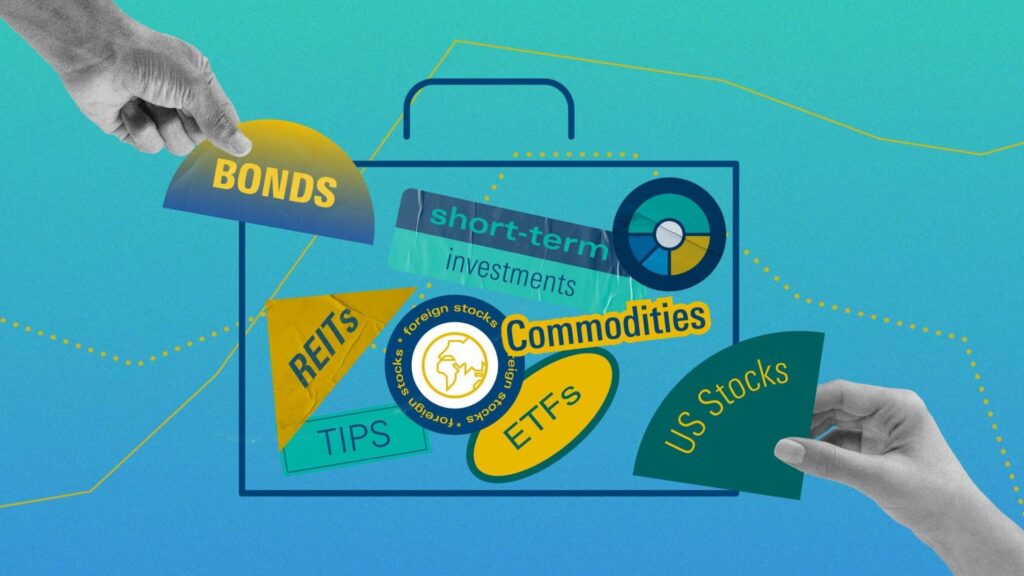As the financial landscape continues to evolve at a dizzying pace, investors are once again confronted with a timeless question: does diversification still reign supreme in 2025? With emerging technologies reshaping markets, new asset classes gaining traction, and global economic shifts challenging traditional strategies, the age-old mantra of spreading risk is being put under the microscope. This article explores whether diversification remains the cornerstone of sound investing or if the future demands a new approach to navigating uncertainty and opportunity.
Table of Contents
- The Evolving Landscape of Investment Strategies
- Balancing Risk and Reward in a Changing Market
- The Role of Alternative Assets in Modern Portfolios
- Technology and Data-Driven Diversification Approaches
- Practical Tips for Building a Resilient Investment Mix
- Frequently Asked Questions
- Key Takeaways

The Evolving Landscape of Investment Strategies
Investment strategies have undergone a significant transformation in recent years, propelled by rapid technological advancements and shifting economic paradigms. Traditional approaches that once relied heavily on broad diversification now face challenges from emerging asset classes like cryptocurrencies, ESG funds, and algorithm-driven portfolios. Investors are increasingly adopting hybrid models, blending time-tested principles with innovative tactics to navigate the complexities of modern markets.
Data analytics and artificial intelligence have become pivotal in shaping these new strategies. With access to real-time insights and predictive models, investors can fine-tune their asset allocation beyond simple diversification. This evolution fosters a more dynamic risk management framework, where the focus extends to identifying correlations and tail risks rather than just spreading investments thinly across sectors.
- Dynamic asset allocation: Adjusting portfolios more frequently based on market signals.
- Alternative investments: Incorporating non-traditional assets such as NFTs, private equity, and digital real estate.
- Ethical considerations: Prioritizing investments with social and environmental impact alongside financial returns.
| Strategy | Key Benefit | Typical Risk Level |
|---|---|---|
| Traditional Diversification | Reduces volatility | Low to Medium |
| AI-Driven Portfolios | Enhanced predictive power | Medium |
| Alternative Assets | Potential for high returns | High |
| ESG Investing | Aligns values with growth | Low to Medium |
Balancing Risk and Reward in a Changing Market
In today’s volatile financial landscape, the delicate dance between risk and reward demands more than just traditional strategies. Investors are increasingly tasked with not only identifying promising opportunities but also with shielding their portfolios from unforeseen shocks. This balancing act requires a nuanced understanding of market dynamics and an agile approach to asset allocation.
Strategic diversification remains a cornerstone, but it now goes beyond spreading investments across sectors or geographies. It involves incorporating alternative assets, such as real estate, commodities, and even digital currencies, to mitigate systemic risks. This broadened horizon can buffer against downturns in any single market segment while still capturing growth elsewhere.
Consider the evolving risk profiles in 2025:
- Tech sector: High growth potential paired with regulatory uncertainties.
- Emerging markets: Attractive valuations but higher geopolitical risks.
- Sustainable investments: Increasingly stable with growing institutional support.
| Asset Class | Risk Level | Expected Reward | Notes |
|---|---|---|---|
| Equities (Global) | Moderate | 7-10% | Best for long-term growth |
| Cryptocurrency | High | 15-25% | Volatile but innovative |
| Real Estate | Low to Moderate | 4-6% | Stable income streams |
| Green Bonds | Low | 2-4% | Growing ESG demand |
Ultimately, success in this shifting environment hinges on flexibility and continuous reassessment. Investors who actively recalibrate their portfolios in response to emerging trends and risks can optimize returns without exposing themselves to outsized losses. This dynamic approach to balancing risk and reward is fast becoming the new standard for prudent investing.

The Role of Alternative Assets in Modern Portfolios
In the evolving landscape of investment, alternative assets have emerged as pivotal components in shaping resilient portfolios. Far beyond traditional stocks and bonds, these assets offer unique risk-return profiles that can help cushion investors against market volatility and economic downturns. From private equity and hedge funds to real estate and commodities, alternative investments provide avenues to tap into uncorrelated returns, enhancing overall portfolio robustness.
One of the most compelling advantages of integrating alternative assets lies in their ability to diversify beyond conventional correlations. Unlike equities, whose performance often moves in tandem during market stress, alternatives like infrastructure or collectibles may behave independently or even counter-cyclically. This dynamic can be invaluable in preserving capital and achieving consistent growth, especially when global markets face turbulence.
Consider the following simplified comparison of asset classes and their typical correlation with the S&P 500:
| Asset Class | Correlation to S&P 500 |
|---|---|
| Stocks | 1.0 (Baseline) |
| Real Estate | 0.5 |
| Hedge Funds | 0.3 |
| Commodities | 0.1 |
| Private Equity | 0.4 |
Investors curious about capitalizing on alternative assets should also consider the following benefits:
- Access to niche markets: Opportunities in emerging industries or unique sectors.
- Potential for higher yields: Especially in private debt or infrastructure projects.
- Inflation hedging: Tangible assets like real estate and commodities often rise with inflation.
- Reduced market noise: Less sensitivity to daily market fluctuations.

Technology and Data-Driven Diversification Approaches
In the ever-evolving landscape of investing, the fusion of technology and data analytics has redefined how diversification is approached. Traditional strategies of spreading assets across sectors and geographies are now augmented by sophisticated algorithms that analyze vast datasets in real-time. This enables investors to identify emerging correlations and hidden risks, crafting portfolios that are not only diversified but dynamically optimized.
Machine learning models have become indispensable, parsing through historical market trends, economic indicators, and alternative data sources such as social sentiment or satellite imagery. These insights inform decisions about which assets are likely to move independently, enhancing the true diversification effect beyond classical asset classes.
- Real-time risk assessment powered by AI
- Customized diversification based on individual risk tolerance
- Integration of alternative data for early trend detection
Below is an illustration of how technology-driven diversification compares with traditional methods in terms of portfolio resilience and growth potential over a five-year horizon:
| Approach | Average Annual Return | Max Drawdown | Volatility |
|---|---|---|---|
| Traditional Diversification | 6.8% | -25% | 12% |
| Tech & Data-Driven Diversification | 8.3% | -18% | 9% |
As this data suggests, leveraging technology not only enhances returns but also mitigates risks more effectively by reducing portfolio volatility and limiting drawdowns. Investors who embrace these innovative approaches may find that the essence of diversification remains, but its execution is smarter, faster, and more adaptive than ever before.

Practical Tips for Building a Resilient Investment Mix
Building a resilient investment mix requires more than just spreading assets across various categories. It demands an understanding of how each component behaves under different market conditions. Start by focusing on asset correlation. Choose investments that react differently to economic shifts – for example, pairing growth stocks with bonds or commodities can help cushion your portfolio during downturns.
Next, embrace the power of regular portfolio reviews. Markets evolve, and so should your mix. Quarterly assessments allow you to rebalance holdings, trimming overperformers and bolstering those with potential. This disciplined approach not only manages risk but also captures growth opportunities before they become mainstream.
Consider integrating alternative investments alongside traditional ones. Real estate, private equity, or even emerging market assets can add layers of protection and growth potential. However, ensure these choices align with your risk tolerance and investment horizon. Below is a simple matrix to help visualize potential asset allocations tailored for resilience:
| Asset Class | Resilience Factor | Suggested Allocation |
|---|---|---|
| Equities (Global) | Moderate | 40-50% |
| Fixed Income | High | 25-35% |
| Alternative Assets | Variable | 10-15% |
| Cash & Equivalents | Very High | 5-10% |
- Diversify within asset classes: Spread investments across sectors, geographies, and industries.
- Utilize dollar-cost averaging: Invest consistently over time to minimize market timing risks.
- Stay informed but avoid overreacting: Market volatility is normal; resilience comes from patience.
Frequently Asked Questions
Q: In 2025, is diversification still considered the cornerstone of a successful investment strategy?
A: Absolutely. Diversification remains a fundamental principle because it helps mitigate risk by spreading investments across various asset classes, sectors, and geographies. While markets evolve, the core idea of not putting all your eggs in one basket continues to protect portfolios from volatility.
Q: How have recent market trends influenced the approach to diversification?
A: Recent trends like increased market volatility, technological disruptions, and geopolitical shifts have underscored the importance of diversification. Investors are now blending traditional assets with alternative investments such as cryptocurrencies, ESG funds, and real estate to build more resilient portfolios.
Q: Are there new types of assets that investors should consider including in their diversified portfolios?
A: Yes. Beyond stocks and bonds, investors are exploring assets like digital currencies, green energy projects, and private equity. These alternatives can offer growth potential and uncorrelated returns, enhancing diversification’s effectiveness in 2025.
Q: Does diversification guarantee profits or eliminate risk entirely?
A: No, diversification does not guarantee profits nor completely eliminate risk. It’s a risk management tool that aims to reduce exposure to any single investment’s downturn. Market-wide events can still impact diversified portfolios, but the overall risk is generally lower than with concentrated holdings.
Q: How can individual investors practically implement diversification in 2025?
A: Individual investors can use exchange-traded funds (ETFs), mutual funds, and robo-advisors to gain instant diversification across various sectors and asset classes. Additionally, regularly rebalancing portfolios ensures alignment with evolving financial goals and market conditions.
Q: Has the concept of diversification changed with technological advancements?
A: Technological advancements have expanded diversification opportunities and made portfolio management more accessible. AI-driven analytics and automated platforms help investors identify new asset classes, optimize asset allocation, and monitor risk more efficiently than ever before.
Q: In a world increasingly focused on sustainability, how does ESG investing fit into diversification?
A: ESG (Environmental, Social, Governance) investing adds a new dimension to diversification by integrating ethical and sustainability factors. Including ESG assets can diversify risks related to regulatory changes and shifting consumer preferences, aligning financial performance with social responsibility.
Q: What role does global diversification play in 2025’s investment landscape?
A: Global diversification remains vital as it allows investors to capitalize on growth in emerging markets and reduce dependence on any single economy. However, geopolitical risks and currency fluctuations require careful consideration when building an international portfolio.
Q: Should younger investors prioritize diversification differently than retirees in 2025?
A: While diversification is important for all, younger investors might lean toward growth-oriented assets with a higher risk tolerance, whereas retirees often prioritize income and capital preservation. Both groups benefit from diversification tailored to their timelines and financial goals.
Q: What is the key takeaway about diversification for investors looking ahead to 2025 and beyond?
A: Diversification remains a timeless investment principle, adapting to new asset classes and market realities. Its essence-managing risk through variety-continues to provide a sturdy foundation for navigating the ever-changing financial landscape.
Key Takeaways
As we step into the evolving landscape of 2025, the question of whether diversification remains the reigning strategy invites both reflection and foresight. While the tools and markets may shift beneath our feet, the core principle of spreading risk continues to offer a steady compass amid uncertainty. Yet, the path forward demands a nuanced approach-one that balances tradition with innovation, and instinct with insight. In the end, diversification may no longer be the sole king, but rather a vital player in a broader, dynamic investment kingdom. The challenge for investors lies not in abandoning diversification, but in mastering how it fits into the new mosaic of opportunities that 2025 presents.

